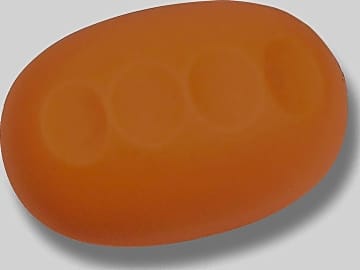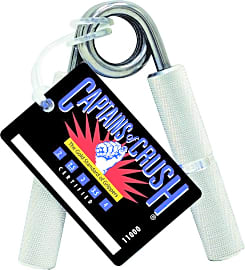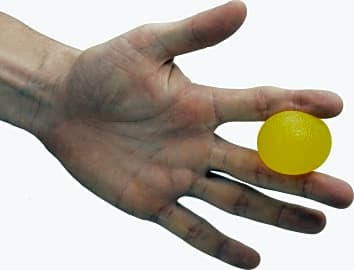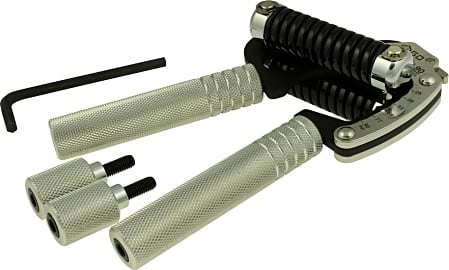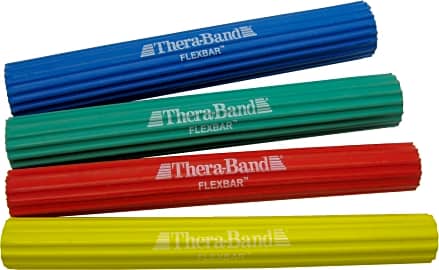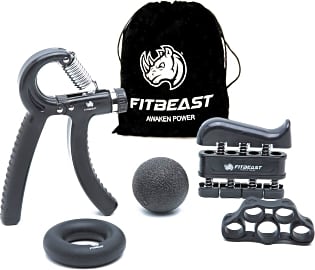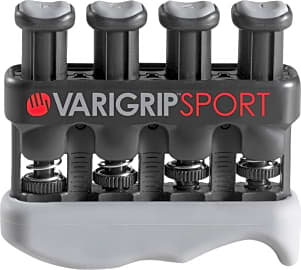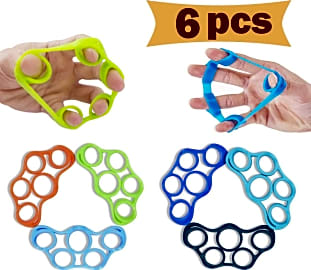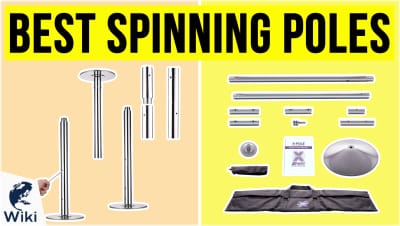The 10 Best Grip Strengtheners

This wiki has been updated 41 times since it was first published in July of 2015. Whether you want a hand exerciser to build strength and dexterity for sporting or musical purposes, or you're looking for something to help with physical therapy for arthritis or carpal tunnel syndrome, one of these grip strengtheners will fit the bill nicely. They're great for anyone who wants to improve their fingers and wrists, from rock climbers to guitar and piano players. When users buy our independently chosen editorial recommendations, we may earn commissions to help fund the Wiki.
Editor's Notes
April 26, 2021:
In this update, we replaced the Sidewinder Pro Plus with the TheraBand FlexBar. The Sidewinder was a good option with useful features like variable resistance, but we didn't feel that it was worth the exceptionally high price. The FlexBar can be used in a similar way to the Sidewinder: grip it with both hands and twist. However its flexible material means that you can also use it for other exercises. For example, you can bend it into a 'U' shape instead of twisting. It's also very lightweight, which can be very helpful for seniors and is a big plus for those who travel often and like to take their equipment with them.
The GD Iron Grip EXT 90 was moved up in the rankings due to its easily adjusted resistance and durable build. The Pnrskter Finger Stretchers were demoted. While their pros certainly might outweigh their cons for some (they're affordable, fairly comfortable compared to others, and small enough to fit in a pocket), they aren't likely to last as long as other options.
January 28, 2020:
Currently, the Kootek Strength Trainer suffers from availability problems, so we've removed it. We've also removed the Xfitness 2.0. Although its overall construction is fine, the metal grips can be quite rough on the hands. If you're looking for a standard, robust metal model, you might look at the popular Ironmind Captains of Crush, instead. You may need to wear gloves while you use it, though, as it too can be a little tough on sensitive palms. For those who need more versatility in the fingers, the Prohands Gripmaster still comes out on top. It's a fine choice for everyone from musicians to athletes. The VariGrip Sport is a similar choice, although it doesn't offer quite as much variety in the resistance levels. And because we know that using the same exerciser over and over again could become a little repetitive, we added the FitBeast Workout Kit, which offers five tools in one handy carrying bag, including a stress ball for those long, tedious days at work.
Finally, we have selected a digital model for fans of metrics and measurements. This Squegg Digital Dynamometer connects to an app on your smartphone, tracking your progress and reps. It even comes with a charging cable for your convenience.
Special Honors
The Block by Tension Climbing Useful for everything from warming up to building strength, The Block by Tension Climbing is a versatile, portable hangboard that is built from sturdy wood and made to last. It boasts several edge offerings from 6 to 25 millimeters, and it can be used individually or in pairs to further the overall utility. tensionclimbing.com
Get A (Stronger) Grip: Grip Strengtheners
It is an ideal tool for use during physical rehab, especially as it is an impact-free activity.
Grip strength training is a critically important, yet often overlooked, form of exercise. While of course, it behooves the competitive weightlifter or mountain climber to have a robust, strong grip, so too can musicians, writers, carpenters, and any who constantly use their hands for fine motor activities enjoy immense benefits from grip work. Grip training can even help a patient recovering from surgery or the person undergoing physical rehabilitation after an injury to enhance the healing process. We'll talk more about the specific needs of specific people momentarily; for now, let us discuss the actual devices most commonly used to improve the strength of the fingers and forearms.
There are three basic types of grip strengthening tools. The first involves using all five fingers at the same time in a fist-clenching motion; the tension in these units is usually created by a taut spring, or sometimes by a resilient material such as silicone. The second variety asks each individual finger to exert effort (usually excluding the thumb); these training tools use multiple smaller springs to create resistance. The third common type of grip strength tool is the self-contained gyroscopic sphere; the user sets an internal gyroscope spinning and then must expend a surprising amount of energy to keep the mechanism moving stably, the result being a great workout for the muscles of the hand and lower arm.
The first category of grip trainers -- that which is operated by squeezing repeatedly with the whole hand -- is a fine choice for anyone who simply wants a stronger grip. This type of tool can help a weightlifter maintain a hold on a barbell or set of dumbbells, can help a pitcher perfect her grasp on a ball, and, in short, can help anyone who wants a more developed forearm and a stronger grasp.
Grip strength tools that challenge each finger individually are ideal for the person who types for many hours a day, for the guitarist or keyboardist, or for the professional or hobbyist constantly using his fingers for precise work like locksmithing, jewelry making, and so forth. These trainers will not build as much forearm muscle or overall grasping strength, but they help build stronger and more resilient fingers that are less at risk for repetitive strain injuries (which can be devastating for the musician or the craftsman, alike).
Finally, the spinning gyroscope trainer does less to develop finger strength than tools from either of the other two categories, but it does more to build up forearm and wrist power. Many people will suffer a wrist injury in their lives (many of us will experience them multiple times) due to the underdeveloped musculature of this critical joint. A gyroscope trainer develops the tendons and muscles that stabilize the wrist, helping prevent both acute and chronic injury. It is an ideal tool for use during physical rehab, especially as it is an impact-free activity.
Ultimately, choosing more than one grip strength trainer and using them each during alternating sessions is likely the best way to build a stronger grip, avoid injury, and to define the muscles of your lower arms.
A Few Words of Caution
The tendons and muscles that control your thumb and fingers, and that stabilize your wrists, are small and fine when compared to many of the larger skeletal muscle of the body. They are relatively easy to injure, and too often these injuries ironically result from exercises intended to strengthen and fortify the very same body parts.
Hand and finger injuries can take weeks or months to heal and are not worth risking.
Start a grip strength training regimen slowly, using a low number of repetitions and, when possible, adjusting the resistance setting of your training tool to a low setting. If you experience any distinct sharp pain that occurs during or shortly after grip training -- not to be confused with the sensation of productive muscle fatigue you should expect -- stop at once and consult a certified medical or fitness training professional. Hand and finger injuries can take weeks or months to heal and are not worth risking.
Likewise, pay attention to how your hands feel throughout the day once you have commenced a grip strength program. If you feel (or even hear) a clicking sound/sensation, you may be straining yourself too much. Just as a gymnast must train to make his or her body more limber and flexible, you must slowly strengthen and stretch the muscles, tendons, and ligaments of your hands. Ease into the regimen with the mentality that you are commencing a marathon, not a sprint.
It's also not a bad idea to treat your hands to some extra care when you are subjecting them to extra effort; consider using a paraffin bath to soothe your fingers, wrists, and forearms after those long grip strength training sessions.
Grip Training Techniques When No Tool Is at Hand
If you are away from home and without your prized grip strength training tool, you can still find many clever ways to exercise your fingers, palms, and forearms.
The simplest way to work on hand and forearm strength without a dedicated device is to complete sets of pushups on your fingertips. This is a decidedly challenging form of exercise, however, and might be too difficult for some people without modification. Feel free to complete fingertip pushups at the knee instead of the full-body extension to your feet.
Raise it repeatedly, alternately twisting the tube away from your body during one lift and toward the next.
You can assemble a simple ad hoc grip strength training tool using nothing more than a dowel or length of pipe, a rope, and any weighted object. Find a cylinder about two feet long and with a circumference approximating the size of your looped thumb and forefinger. Secure a four or five-foot length of rope to the center of the tube, and tie the other end around an object weighing between five and ten pounds (more if you are quite fit, less if you are in the early days of training). Now hold your arms out straight ahead and grasp the cylinder in your hands, then commence a rolling motion and lift the object upward by coiling the rope. Raise it repeatedly, alternately twisting the tube away from your body during one lift and toward the next.
Last, you can enhance your grip strength simply by holding heavy objects, especially when you vary their shape and type. A brick that is held between the fingers of hands lowered by your sides builds finger strength; a dumbbell held by a hand wrapped into a fist builds forearm strength. Spend time holding different items of varied shapes and weights and your grip strength will grow.



